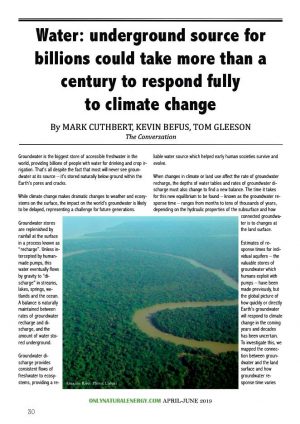 Groundwater is the biggest store of accessible freshwater in the world, providing billions of people with water for drinking and crop irrigation. That’s all despite the fact that most will never see groundwater at its source – it’s stored naturally below ground within the Earth’s pores and cracks.
Groundwater is the biggest store of accessible freshwater in the world, providing billions of people with water for drinking and crop irrigation. That’s all despite the fact that most will never see groundwater at its source – it’s stored naturally below ground within the Earth’s pores and cracks.
While climate change makes dramatic changes to weather and ecosystems on the surface, the impact on the world’s groundwater is likely to be delayed, representing a challenge for future generations.
Groundwater stores are replenished by rainfall at the surface in a process known as “recharge”. Unless intercepted by human-made pumps, this water eventually flows by gravity to “discharge” in streams, lakes, springs, wetlands and the ocean. A balance is naturally maintained between rates of groundwater recharge and discharge, and the amount of water stored underground.
Groundwater discharge provides consistent flows of freshwater to ecosystems, providing a reliable water source which helped early human societies survive and evolve.
When changes in climate or land use affect the rate of groundwater recharge, the depths of water tables and rates of groundwater discharge must also change to find a new balance. The time it takes for this new equilibrium to be found – known as the groundwater response time – ranges from months to tens of thousands of years, depending on the hydraulic properties of the subsurface and how connected groundwater is to changes at the land surface.
Estimates of response times for individual aquifers – the valuable stores of groundwater which humans exploit with pumps – have been made previously, but the global picture of how quickly or directly Earth’s groundwater will respond to climate change in the coming years and decades has been uncertain. To investigate this, we mapped the connection between groundwater and the land surface and how groundwater response time varies across the world.
The long memory of groundwater
We found that below approximately three quarters of the Earth’s surface, groundwater response times last over 100 years. Recharge happens unevenly around the world so this actually represents around half of the active groundwater flow on Earth.
This means that in these areas, any changes to recharge currently occurring due to climate change will only be fully realised in changes to groundwater levels and discharge to surface ecosystems more than 100 years in the future. We also found that, in general, the driest places on Earth have longer groundwater response times than more humid areas, meaning that groundwater stores beneath deserts take longer to fully respond to changes in recharge. In wetter areas where the water table is closer to the surface, groundwater tends to intersect the land surface more frequently, discharging to streams or lakes.This means there are shorter distances between recharge and discharge areas helping groundwater stores come to equilibrium more quickly in wetter landscapes.Hence, some groundwater systems in desert regions like the Sahara have response times of more than 10,000 years. Groundwater there is still responding to changes in the climate which occurred at the end of the last glacial period, when that region was much wetter.In contrast, many low lying equatorial regions, such as the Amazon and Congo basins, have very short response times and will re-equilibrate on timescales of less than a decade, largely keeping pace with climate changes to the water cycle.
Geology also plays an important role in governing groundwater responses to climate variability. For example, the two most economically important aquifers in the UK are the limestone chalk and the Permo-Triassic sandstone.
Despite both being in the UK and existing in the same climate, they have distinctly different hydraulic properties and, therefore, groundwater response times. Chalk responds in months to years while the sandstone aquifers take years to centuries. In comparison to surface water bodies such as rivers and lakes which respond very quickly and visibly to changes in climate, the hidden nature of groundwater means that these vast lag times are easily forgotten. Nevertheless, the slow pace of groundwater is very important for managing freshwater supplies.
The long response time of the UK’s Permo-Triassic sandstone aquifers means that they may provide excellent buffers during drought in the short term. Relying on groundwater from these aquifers may seem to have little impact on their associated streams and wetlands, but diminishing flows and less water could become more prevalent as time goes on. This is important to remember when making decisions about what rates of groundwater abstraction are sustainable. Groundwater response times may be much longer than human lifetimes, let alone political and electoral cycles.
Mark Cuthbert, Kevin Befus, Tom Gleeson
Originally published
by the Conversation
11 February 2019



